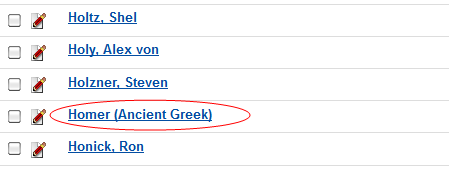Cataloguing
Titles de-duplication and Copies data
When you save on a Titles de-duplication process, you can now configure whether or not only the Copies data is moved across from one title to the preferred title. If only the Copies data is moved across, the audit and transaction history are still also retained.
To configure set the De-duplicate Copies Only field either in:
|
System Administration> OLIB Defaults |
The Yes or No value takes effect when running the de-duplication process across all Titles layouts (RDA, General etc..) |
|
Titles> Admin (RDA Layout) Titles> Related Items and Control data (other layouts) |
The De-duplicate Copies Only field will need to be added to the layout by the System Administrator, using Layout Manager. (Suggested placement: above the Duplicates field). If this value is null, the setting in OLIB Defaults will take effect. |
If you want to apply the same policy for Title and Copies duplicates on a system wide basis, regardless of the layout, then set OLIB Defaults: De-duplicate Copies Only to Yes or No.
System Administration> OLIB Defaults: Cataloguing Defaults:
If you want to address de-duplication on a record by record basis, then the System Manager should add the attribute - De-duplicate Copies Only? (ti_dedupe_copies_only) - to your Titles layout, e.g. RDA Admin sheet, above the Duplicates button:
Titles Control / Admin sheet:
If you want to de-duplicate copies on a Title record by record basis:
- Leave OLIB Defaults: Cataloguing Defaults: De-duplicate Copies Only set to NULL.
- Search for the relevant Title in Titles.
- Add 1 or more duplicate titles to the Duplicates field.
- Set De-duplicate Copies Only
- Yes: OLIB will transfer only Copies data to the preferred Title
- No: OLIB will transfer across Copies data and other authority headings, e.g. Authors, Subjects, Classes
- Save the Title record for the de-duplication to take effect.
Parent title can be displayed without title number
When you view one of the contents titles, the link to the parent will be seen in the Part of field. The standard display includes the Title and the internal OLIB title number.
If you do not want the title number to display, the system administrator can use Layout Manager to change the Parent Title attribute:
From titleno and title (ti_articleno) To title only (ti_articleno_ti_only):
Allow Delete Copies with Checks when the Titles has a trap attached
A number of checks are carried out to ensure that deleting the Title or Copy records would not result in data corruption in your database.
When you use the Delete Copies with Checks action, OLIB now allows copies to be deleted if the Title has a trap attached:
VIAF Characters Extended
These name authority identifiers are available in the Names layout from Service Pack 12:
|
Name Authority Identifiers |
Layout Manager Attributes |
Character Length |
|
ORCid (Open Researcher and Contributor ID) |
ORCid (au_orcid) |
VARCHAR2(20) |
|
VIAF (Virtual International Authority File) |
VIAF (au_viaf) |
VARCHAR2(30) |
|
ISNI (International Standard Name Identifier) |
ISNI (au_isni) |
VARCHAR2(20) |
The character length for VIAF has now been extended from 20 characters to 30 (VIAF requirement is up to 22 characters).
Cataloguing: Default ISxN type
In Media Types, it is now possible to select the default ISxN from the Default ISxN Type drop down:
When cataloguing in Titles, after you enter/scan in the ISxN, OLIB checks that the number entered is valid for the default ISxN type.
Designation field
The designation field is now available in the names hitlist and in the names field on the title record.
This additional field for Names - au_designation – will need to be added using the Layout Manager tool.
Titles – Names section:

Names hitlist:

Cataloguing: RDA updates
Three key updates were developed in Service Pack 13:
1. The MARC import now handles tags 336, 337 and 338 – subfield b.
(The remaining subfields are descriptions of the imported standard codes held in OLIB.
$b is the critical code field for the import/export
$a (etc) is generated from the value in $b by using the predefined, unchangeable, values delivered with OLIB)
These can be viewed in the Media Types domain:
- Mode of Issuance: this is not explicitly exported to the MARC record. The MARC export process will continue to populate Leader/07 and Leader/19 as before, to represent the mode of issuance
- Content Type: this will be imported/exported in 336 $b. Subfields $a and $0 will be generated during export from predefined data managed by OCLC
- Media Type: this will be imported/exported in 337 $b. Subfields $a and $0 will be generated during export from predefined data managed by OCLC
- Carrier Type: this will be imported/exported in 338 $b. Subfields $a and $0 will be generated during export from predefined data managed by OCLC
2. The RDA fields now have attributes in the Archived Titles domain.
These can be seen in Archives> Archived Titles when you view a record using the RDA layout:
3. Additional fields and attributes are now available for Name authority records.
- Field of Activity, Start and End period, URI and source
- Occupation, Start and End period, URI and source
- Complete form of name (for 278 $q), URI and source
- Biographical data (with continuation), and URI
These are not added to the names layouts automatically. The system manager would need to add them using Layout Manager.
